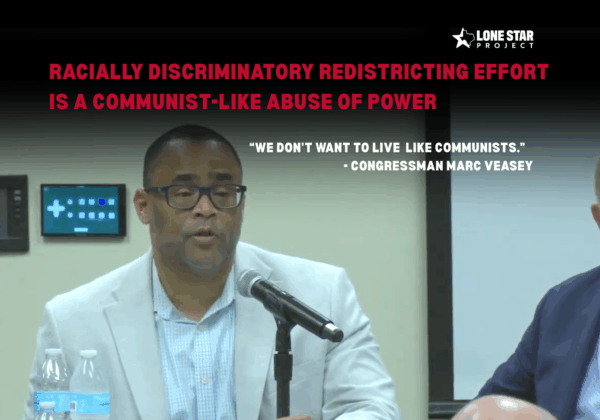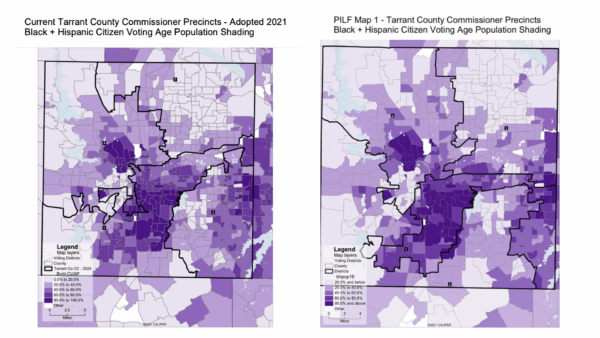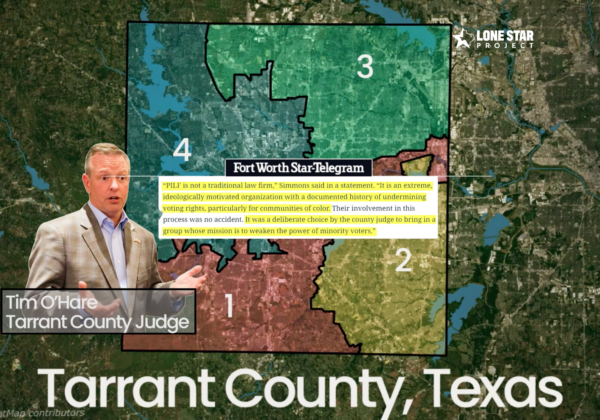Today, the Lone Star Project will look at north Texas Congressional District 33 (CD33), the only true new minority opportunity district in the court’s plan.
 New North Texas District 33
New North Texas District 33
With over 2.1 million African Americans and Hispanics living in Tarrant and Dallas counties, a compelling case was made in court by Lone Star Project supported plaintiffs, the NAACP and national LULAC that the size and compactness of the minority population in Tarrant and Dallas counties warrants the creation of two additional minority opportunity districts in the area. As a result, it is not surprising that the court decided to locate at least one new minority opportunity district in North Texas.
New CD33 is the only truly new minority opportunity district in the Court-ordered map. The other “new” minority districts simply replace existing districts where minority citizens had already elected their candidate of choice.
New District 33 includes large parts of both Tarrant and Dallas counties. It is anchored in the African American and integrated neighborhoods in the City of Fort Worth and then extends east to include part of Arlington and then further east to include part of Grand Prairie, part of Irving and the north Oak Cliff area of Dallas.
CD33 is overwhelmingly Democratic
While some Republicans may consider running in new District 33, they have no chance. District 33 is safely Democratic. Every Democratic candidate on the general election ballot in 2008 and in 2010 carried the district easily.
- President Obama and Rick Noriega both received almost 70 percent of the vote in the 2008 General Election (source: Texas Legislative Council).
- Bill White and Linda Chavez-Thompson both received approximately 65 percent of the vote in 2010 (source: Texas Legislative Council).
Democratic Primary Winner Must Build a Coalition
The likely winner of a Democratic primary in CD33 will be a candidate able to gain support from a coalition of African American, Hispanic and some Anglo voters.
- While the district has a majority Hispanic voting age population of 61 percent, the Hispanic citizen voting age population is only 39 percent – well short of a majority – and the black citizen voting age population is 25 percent (source: Texas Legislative Council).
- A disproportionate number of Anglo voters will participate in the Republican primary, so African Americans and Hispanics will comprise the majority of Democratic primary voters.
The winner in CD33 will probably not be able to prevail by relying only on Hispanic or only on African American support. They will have to win support from both. Further, support from the relatively small number of Anglos who vote in the Democratic primary could impact a close election. It is clearly a coalition district where every vote in the primary will matter.
In fact, when commenting upon District 33 during court deliberations, Nina Perales, the legal council for the Latino Task Force, refused to characterize the district as a Hispanic opportunity district, saying instead it is “just a district” (source: Perez v. Perry, pg. 118). More recently, in a Texas Tribune guest column, she conceded that African Americans and Hispanics had an equal opportunity to elect their candidate of choice (source: Texas Tribune).
A candidate from Tarrant County has an advantage
The advantage may be more regional than racial. Demographics, turnout and voter history appear to favor a candidate with a Tarrant County political base.
- In the 2004 and 2006 Democratic primaries, Tarrant County outvoted Dallas County in CD33 (source: Texas Legislative Council). Tarrant Democrats cast 56 percent of the votes in the high turnout Barack Obama vs Hillary Clinton race in 2008. The two counties broke about even in the very low turnout Democratic primary in 2010 (source: Texas Legislative Council). The 2012 Democratic primary will likely be somewhere between the two, so it is fair to anticipate an advantage in turnout for Tarrant.
- The Dallas portion of the district has a fewer number of so-called “likely voters” who participated in both the 2008 and 2010 primaries. In short, there is a smaller hard base of Democratic voters.
- A Tarrant-based candidate has a larger natural base and can benefit from the turnout of both African Americans and Hispanics who already have a history of voting regularly. In short, the needed coalition is somewhat easier to build when starting from Tarrant rather than starting from Dallas.



